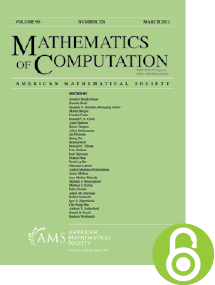On generalized averaged Gaussian formulas. II
HTML articles powered by AMS MathViewer
- by Miodrag M. Spalević PDF
- Math. Comp. 86 (2017), 1877-1885 Request permission
Abstract:
Recently, by following the results on characterization of positive quadrature formulae by Peherstorfer, we proposed a new $(2\ell +1)$-point quadrature rule $\widehat G_{2\ell +1}$, referred to as a generalized averaged Gaussian quadrature rule. This rule has $2\ell +1$ nodes and the nodes of the corresponding Gauss rule $G_\ell$ with $\ell$ nodes form a subset. This is similar to the situation for the $(2\ell +1)$-point Gauss-Kronrod rule $H_{2\ell +1}$ associated with $G_\ell$. An attractive feature of $\widehat G_{2\ell +1}$ is that it exists also when $H_{2\ell +1}$ does not. The numerical construction, on the basis of recently proposed effective numerical procedures, of $\widehat G_{2\ell +1}$ is simpler than the construction of $H_{2\ell +1}$. A disadvantage might be that the algebraic degree of precision of $\widehat G_{2\ell +1}$ is $2\ell +2$, while the one of $H_{2\ell +1}$ is $3\ell +1$. Consider a (nonnegative) measure $d\sigma$ with support in the bounded interval $[a,b]$ such that the respective orthogonal polynomials, above a specific index $r$, satisfy a three-term recurrence relation with constant coefficients. For $\ell \ge 2r-1$, we show that $\widehat G_{2\ell +1}$ has algebraic degree of precision at least $3\ell +1$, and therefore it is in fact $H_{2\ell +1}$ associated with $G_\ell$. We derive some interesting equalities for the corresponding orthogonal polynomials.References
- D. Calvetti, G. H. Golub, W. B. Gragg, and L. Reichel, Computation of Gauss-Kronrod quadrature rules, Math. Comp. 69 (2000), no. 231, 1035–1052. MR 1677474, DOI 10.1090/S0025-5718-00-01174-1
- T. S. Chihara, An introduction to orthogonal polynomials, Mathematics and its Applications, Vol. 13, Gordon and Breach Science Publishers, New York-London-Paris, 1978. MR 0481884
- Dušan Lj. Djukić, Lothar Reichel, and Miodrag M. Spalević, Truncated generalized averaged Gauss quadrature rules, J. Comput. Appl. Math. 308 (2016), 408–418. MR 3523014, DOI 10.1016/j.cam.2016.06.016
- C. F. Gauss, Methodus nova integralium valores per approximationem inveniendi, Commentationes Societatis Regiae Scientiarum Göttingensis Recentiores 3 (1814). Also in Werke III, 163–196.
- Walter Gautschi, Orthogonal polynomials: computation and approximation, Numerical Mathematics and Scientific Computation, Oxford University Press, New York, 2004. Oxford Science Publications. MR 2061539
- W. Gautschi, OPQ suite (http://www.cs.purdue.edu/archives/2001/wxg/codes).
- Walter Gautschi, A historical note on Gauss-Kronrod quadrature, Numer. Math. 100 (2005), no. 3, 483–484. MR 2195449, DOI 10.1007/s00211-005-0592-7
- Walter Gautschi and Sotorios E. Notaris, Gauss-Kronrod quadrature formulae for weight functions of Bernstein-Szegő type, J. Comput. Appl. Math. 25 (1989), no. 2, 199–224. MR 988057, DOI 10.1016/0377-0427(89)90047-2
- Walter Gautschi and Sotirios E. Notaris, Stieltjes polynomials and related quadrature formulae for a class of weight functions, Math. Comp. 65 (1996), no. 215, 1257–1268. MR 1344614, DOI 10.1090/S0025-5718-96-00732-6
- Walter Gautschi and Theodore J. Rivlin, A family of Gauss-Kronrod quadrature formulae, Math. Comp. 51 (1988), no. 184, 749–754. MR 958640, DOI 10.1090/S0025-5718-1988-0958640-X
- Gene H. Golub and John H. Welsch, Calculation of Gauss quadrature rules, Math. Comp. 23 (1969), 221-230; addendum, ibid. 23 (1969), no. 106, loose microfiche suppl, A1–A10. MR 0245201, DOI 10.1090/S0025-5718-69-99647-1
- Carl Jagels, Lothar Reichel, and Tunan Tang, Generalized averaged Szegő quadrature rules, J. Comput. Appl. Math. 311 (2017), 645–654. MR 3552731, DOI 10.1016/j.cam.2016.08.038
- D. K. Kahaner and G. Monegato, Nonexistence of extended Gauss-Laguerre and Gauss-Hermite quadrature rules with positive weights, Z. Angew. Math. Phys. 29 (1978), no. 6, 983–986 (English, with German summary). MR 523866, DOI 10.1007/BF01590820
- A. S. Kronrod, Integration with control of accuracy, Soviet Physics Dokl. 9 (1964), 17–19. MR 0199960
- Dirk P. Laurie, Calculation of Gauss-Kronrod quadrature rules, Math. Comp. 66 (1997), no. 219, 1133–1145. MR 1422788, DOI 10.1090/S0025-5718-97-00861-2
- Attila Máté, Paul Nevai, and Walter Van Assche, The supports of measures associated with orthogonal polynomials and the spectra of the related selfadjoint operators, Proceedings of the U.S.-Western Europe Regional Conference on Padé Approximants and Related Topics (Boulder, CO, 1988), 1991, pp. 501–527. MR 1113940, DOI 10.1216/rmjm/1181073020
- Giovanni Monegato, An overview of the computational aspects of Kronrod quadrature rules, Numer. Algorithms 26 (2001), no. 2, 173–196. MR 1829797, DOI 10.1023/A:1016640617732
- Franz Peherstorfer, On positive quadrature formulas, Numerical integration, IV (Oberwolfach, 1992) Internat. Ser. Numer. Math., vol. 112, Birkhäuser, Basel, 1993, pp. 297–313. MR 1248412
- Franz Peherstorfer, Positive quadrature formulas. III. Asymptotics of weights, Math. Comp. 77 (2008), no. 264, 2241–2259. MR 2429883, DOI 10.1090/S0025-5718-08-02119-4
- Franz Peherstorfer and Knut Petras, Ultraspherical Gauss-Kronrod quadrature is not possible for $\lambda >3$, SIAM J. Numer. Anal. 37 (2000), no. 3, 927–948. MR 1749243, DOI 10.1137/S0036142998327744
- Franz Peherstorfer and Knut Petras, Stieltjes polynomials and Gauss-Kronrod quadrature for Jacobi weight functions, Numer. Math. 95 (2003), no. 4, 689–706. MR 2013124, DOI 10.1007/s00211-002-0412-2
- Lothar Reichel, Giuseppe Rodriguez, and Tunan Tang, New block quadrature rules for the approximation of matrix functions, Linear Algebra Appl. 502 (2016), 299–326. MR 3490795, DOI 10.1016/j.laa.2015.07.007
- Lothar Reichel, Miodrag M. Spalević, and Tunan Tang, Generalized averaged Gauss quadrature rules for the approximation of matrix functionals, BIT 56 (2016), no. 3, 1045–1067. MR 3540471, DOI 10.1007/s10543-015-0592-7
- Miodrag M. Spalević, On generalized averaged Gaussian formulas, Math. Comp. 76 (2007), no. 259, 1483–1492. MR 2299784, DOI 10.1090/S0025-5718-07-01975-8
- Miodrag M. Spalević, A note on generalized averaged Gaussian formulas, Numer. Algorithms 46 (2007), no. 3, 253–264. MR 2374184, DOI 10.1007/s11075-007-9137-8
- H. S. Wilf, Mathematics for the Physical Sciences, Wiley, New York, 1962.
Additional Information
- Miodrag M. Spalević
- Affiliation: Department of Mathematics, University of Beograd, Faculty of Mechanical Engineering, Kraljice Marije 16, 11120 Belgrade 35, Serbia
- MR Author ID: 600543
- Email: mspalevic@mas.bg.ac.rs
- Received by editor(s): February 13, 2016
- Published electronically: November 8, 2016
- Additional Notes: The author was supported in part by the Serbian Ministry of Science and Technological Development
- © Copyright 2016 American Mathematical Society
- Journal: Math. Comp. 86 (2017), 1877-1885
- MSC (2010): Primary 65D30, 65D32; Secondary 41A55
- DOI: https://doi.org/10.1090/mcom/3225
- MathSciNet review: 3626541


